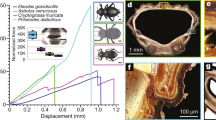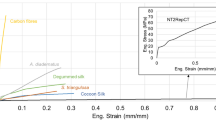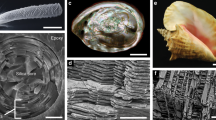Abstract
Natural materials are renowned for their strength and toughness1,2,3,4,5. Spider dragline silk has a breakage energy per unit weight two orders of magnitude greater than high tensile steel1,6, and is representative of many other strong natural fibres3,7,8. The abalone shell, a composite of calcium carbonate plates sandwiched between organic material, is 3,000 times more fracture resistant than a single crystal of the pure mineral4,5. The organic component, comprising just a few per cent of the composite by weight9, is thought to hold the key to nacre's fracture toughness10,11. Ceramics laminated with organic material are more fracture resistant than non-laminated ceramics11,12, but synthetic materials made of interlocking ceramic tablets bound by a few weight per cent of ordinary adhesives do not have a toughness comparable to nacre13. We believe that the key to nacre's fracture resistance resides in the polymer adhesive, and here we reveal the properties of this adhesive by using the atomic force microscope14 to stretch the organic molecules exposed on the surface of freshly cleaved nacre. The adhesive fibres elongate in a stepwise manner as folded domains or loops are pulled open. The elongation events occur for forces of a few hundred piconewtons, which are smaller than the forces of over a nanonewton required to break the polymer backbone in the threads. We suggest that this ‘modular’ elongation mechanism might prove to be quite general for conveying toughness to natural fibres and adhesives, and we predict that it might be found also in dragline silk.
This is a preview of subscription content, access via your institution
Access options
Subscribe to this journal
Receive 51 print issues and online access
$199.00 per year
only $3.90 per issue
Buy this article
- Purchase on Springer Link
- Instant access to full article PDF
Prices may be subject to local taxes which are calculated during checkout



Similar content being viewed by others
References
Hinman, M., Dong, Z., Xu, M. & Lewis, R. V. in Biomolecular Materials(eds Viney, C., Case, S. T. &Waite, J. H.) 25–34 (Materials Research Soc., Pittsburgh, 1993).
Qin, X., Coyne, K. J. & Waite, J. H. Anovel natural copolymer: A collagenous molecule from mussel byssus contains silk fibroin-like domains. Am. Zool. 37, 125A (1997).
Waite, J. H., Qin, X. X. & Coyne, K. J. The peculiar collagens of mussel byssus. Matrix Biol. 17, 93–106 (1998).
Currey, J. D. Mechanical properties of mother of pearl in tension. Proc. R. Soc. Lond. B 196, 443–463 (1977).
Jackson, A. P., Vincent, J. F. & Turner, R. M. The mechanical design of nacre. Proc. R. Soc. Lond. B 234, 415–440 (1988).
Heslot, H. Artificial fibrous proteins: A review. Biochimie (Paris) 80, 19–31 (1998).
Vollrath, F. & Edmonds, D. T. Modulation of the mechanical properties of spider silk by coating with water. Nature 340, 305–307 (1989).
Qin, X. X., Coyne, K. J. & Waite, J. H. Tough tendons. Musse byssus has collagen with silk-like domains. J. Biol. Chem. 272, 32623–32627 (1997).
Watable, N. & Wilbur, K. M. (eds.) The Mechanisms of Biomineralization in Invertebrates and Plants(Univ. South Carolina Press, Columbia, SC, 1976).
Weiner, S. Organization of extracellularly mineralized tissues: a comparative study of biological crystal growth. CRC Crit. Rev. Biochem. 20, 365–408 (1986).
Jackson, A. P., Vincent, J. F. V. & Turner, R. M. Aphysical model of nacre. Composites Sci. Technol. 36, 255–266 (1989).
Clegg, W. J., Kendall, K., Alford, N. M., Button, T. W. & Birchall, J. D. Asimple way to make tough ceramics. Nature 347, 455–457 (1990).
Almqvist, N. et al. Methods for fabricating and characterizing a new generation of biomimetic materials. Mater. Sci. Eng. C 7(1), 37–43 (1999).
Binnig, G., Quate, C. F. & Gerber, C. The atomic force microscope. Phys. Rev. Lett. 56, 930–933 (1986).
Addadi, L. & Weiner, S. Biomineralization—A pavement of pearl. Nature 389, 912–915 (1997).
Schäffer, T. E. et al. Does abalone nacre form by heteroepitaxial nucleation or by growth through mineral bridges? Chem. Mater. 9, 1731–1740 (1997).
Shen, X., Belcher, A. M., Hansma, P. K., Stucky, G. D. & Morse, D. E. Molecular cloning and characterization of lustrin A, a matrix protein from shell and pearl nacre of Haliotis rufescens. J. Biol. Chem. 272, 32472–32481 (1997).
Rief, M., Gautel, M., Oesterhelt, F., Fernandez, J. M. & Gaub, H. Single molecule force spectroscopy on polysaccharides by atomic force microscopy. Science 276, 1295–1297 (1997).
Rief, M., Gautel, M., Oesterhelt, F., Fernandez, J. M. & Gaub, H. E. Reversible unfolding of individual titin immunoglobulin domains by AFM. Science 276, 1109–1112 (1997).
Grandbois, M., Beyer, M., Rief, M., Clausen-Schaumann, H. & Gaub, H. E. How strong is a covalent bond? Science 283, 1727–1730 (1999).
Mehta, A. D., Rief, M., Spudich, J. A., Smith, D. A. & Simmons, R. M. Single-molecule biomechanics with optical methods. Science 283, 1689–1695 (1999).
Kellermayer, M. S., Smith, S. B., Granzier, H. L. & Bustamante, C. Folding-unfolding transitions in single titin molecules characterized with laser tweezers. Science 276, 1112–1116 (1997).
Keller, T. C. S. Molecular bungees. Nature 387, 233–235 (1997).
Tskhovrebova, L., Trinick, J., Sleep, J. A. & Simmons, R. M. Elasticity and unfolding of single molecules of the giant muscle protein titin. Nature 387, 308–312 (1997).
Al-Hassani, S. T. S. & Kaddour, A. S. Strain rate effects on GRP, KRP and CFRP composite laminates. Key Eng. Mater. 141, 427–452 (1998).
Greenwood, J. H. & Rose, P. G. Compressive behaviour of Kevlar 49 fibres and composites. J. Mater. Sci. 9, 1809–1814 (1974).
Lu, H., Isralewitz, B., Krammer, A., Vogel, V. & Schulten, K. Unfolding of titin immunoglobulin domains by steered molecular dynamics simulation. Biophys. J. 75, 662–671 (1988).
Slater, G. W., Hubert, S. J. & Nixon, G. I. Construction of approximate entropic forces for finitely extensible nonlinear elastic (FENE) polymers. Macromol. Theory Simulat. 3, 695–704 (1994).
Acknowledgements
We thank F. Lange and E. Kramer for help in understanding polymers, and H. Gaub and his group members both for helping to teach us how to unfold proteins, and for suggesting that organic components of abalone shells might be a good system in which to study polymer unfolding. This work was supported by the NSF (P.K.H.), by NSF through the Materials Research Laboratory, the Office of Naval Research, the Army Research Office MURI program, and the NOAA National Sea Grant College Program.
Author information
Authors and Affiliations
Corresponding author
Rights and permissions
About this article
Cite this article
Smith, B., Schäffer, T., Viani, M. et al. Molecular mechanistic origin of the toughness of natural adhesives, fibres and composites. Nature 399, 761–763 (1999). https://doi.org/10.1038/21607
Received:
Accepted:
Issue Date:
DOI: https://doi.org/10.1038/21607
This article is cited by
-
Heterostructured metal matrix composites for structural applications: a review
Journal of Materials Science (2024)
-
Force transmission by retrograde actin flow-induced dynamic molecular stretching of Talin
Nature Communications (2023)
-
Promoted Comprehensive Properties of Polyisoprene Rubber with Extremely High Fatigue Resistance Enabled by Oligopeptide Aggregates
Chinese Journal of Polymer Science (2023)
-
Macroscale double networks: highly dissipative soft composites
Polymer Journal (2022)
-
Biomimetic “Nacre-like” Films Prepared via Layer-by-Layer Self-assembly of Mica, Polyvinyl Alcohol and Polymethyl Methacrylate
Journal of Wuhan University of Technology-Mater. Sci. Ed. (2022)
Comments
By submitting a comment you agree to abide by our Terms and Community Guidelines. If you find something abusive or that does not comply with our terms or guidelines please flag it as inappropriate.



